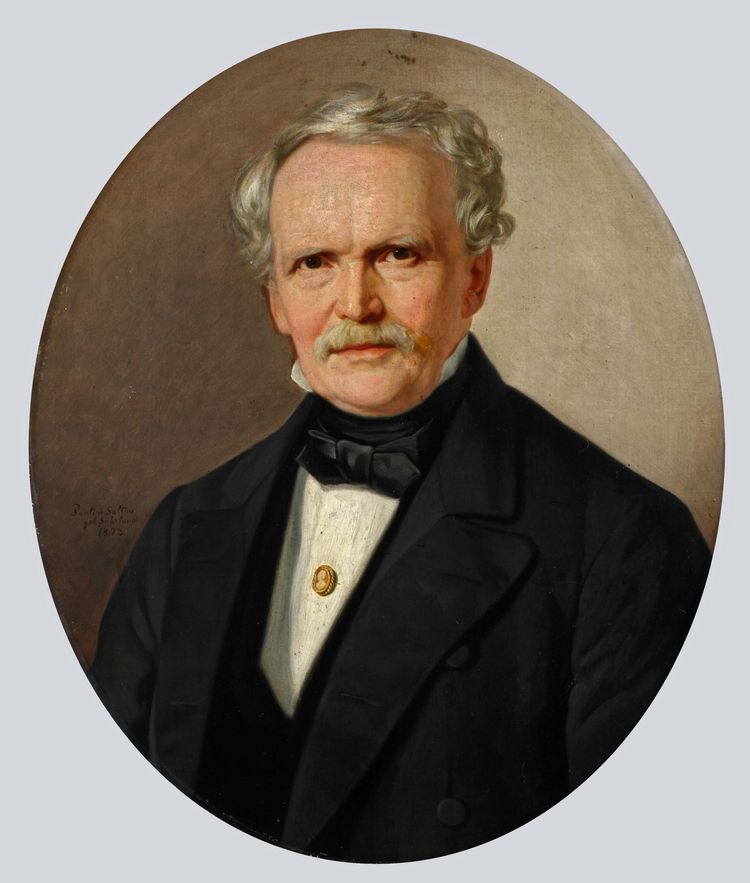Georg Adolf Demmler was born at Berlin on 22 December 1804.
From 1819, after schooling at Güstrow (1813─1819), Demmler studied at the Berlin Academy of Art and Architecture. Because of his membership of Arminia, a secret students’ society, he was dismissed from the academy in 1823.
In 1824 he was appointed supervisor of works for the senior architect of the province, Carl Heinrich Wünsch, in Mecklenburg-Schwerin. In the year of his appointment Demmler was already submitting designs for the construction of the Government buildings in the Old Garden and was later also commissioned with their construction on the site of a former Franciscan friary.
In 1832 Grand Duke Paul Friedrich (1800─1842) appointed Demmler Chief Architect and granted him a study tour of Europe.
In 1835 Demmler was named chief architect of the province and in 1837 the chief court architect. He was also granted the title of court architect in 1841. During his time of service Demmler drafted many plans for the expansion of Schwerin in the grand manner.
Demmler’s influence is visible in the character of today’s city, once the Residence city, for example by planning and constructing the Old Palace (1837), the Stables (1838─1842) and by building the Arsenal at the Pfaffenteich (1840─1844). He worked as an architect throughout Mecklenburg, for instance at the theatre in Güstrow (1828), now the Ernst-Barlach theatre, and the Dobbertin convent church (1827).
His most dazzling achievement was his contribution to the remodelling of Schwerin Castle (1843─1851). Grand Duke Paul Friedrich had originally planned to erect a new castle in the classicist style in the Old Garden. However, in 1842 Paul Friedrich died and his son Friedrich Franz II ascended the throne and stopped all building work in the Old Garden. The young Grand Duke preferred to live in Schwerin Castle, which was now feeling the effects of time. Friedrich Franz II ordered a comprehensive remodelling and reconstruction of the Castle to ensure that this could be done in a manner consonant with his status. Demmler submitted three designs in succession which he had drafted in collaboration with his supervisor of works, Hermann Willebrand. The first and second were rejected after exhaustive discussions at Court in Schwerin and Berlin. Friedrich Franz II wished to preserve the old elements of the castle and simply renovate them. This affected the Long House and the Bishop’s House: these were to be left largely untouched. The underlying idea was to make the renovated castle a frame for the old.
In 1844 Demmler and Willebrand travelled through South Germany, France and England to gather new ideas and impressions. The result was a design based on the château of Chambord on the Loire, and this was approved at Court in Schwerin and Berlin. Demmler and Willebrand had been inspired by the French Renaissance château of Chambord and created a design which took account of the fact that the Castle was visible all round, so that it would be equally magnificent on every side. This form of building was then uncommon, because it had hitherto been usual to construct buildings in the classicist style, i.e. with a clear and symmetrical façade harking back to Greek or Roman models.
During his professional career Demmler advocated fairer pay, the protection of apprentices from exploitation and insurance against illness and injury. On his own initiative he also founded a school of construction and a Sunday school for craft apprentices, where he taught mathematics and technical drawing as a volunteer.
In 1848─1849 Demmler joined the reform association in which he advocated the Basic State Law. The Grand Duke Friedrich Franz II repeatedly warned Demmler about these activities. In 1851 he anticipated his dismissal by resigning. Despite having left the Grand Ducal service he submitted an “Extension and embellishment plan” for Schwerin in 1866.
In the following years he participated in many congresses of the nascent labour and trades union movements. In 1878 Demmler withdrew from active politics because of the Socialist Laws.
He died at Schwerin on 2 January 1886.
Written by Martin Funk, Voluntary Social Year 2016/17.

